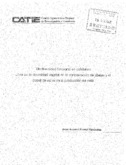| dc.contributor.author | Florez Fernández, Jaime A. | |
| dc.date.accessioned | 2014-10-20T05:06:23Z | |
| dc.date.available | 2014-10-20T05:06:23Z | |
| dc.date.issued | 2001 | es_ES |
| dc.identifier | 337039 | es_ES |
| dc.identifier.uri | https://repositorio.catie.ac.cr/handle/11554/5161 | |
| dc.description | Tesis (M. Sc) -- CATIE, Turrialba (Costa Rica), 2001 | es_ES |
| dc.description | 94 p. | |
| dc.description | 11 ilus. 16 tab. | |
| dc.description | Bib. p. 74-82 | |
| dc.description.abstract | Esta investigación caracterizó la abundancia y diversidad de abejas y avispas en cafetales con diferentes condiciones de sombra y bosque circundante en cuatro zonas cafeteras de Costa Rica y evaluó el efecto de estos insectos sobre la Producción de café. El área de bosque circundante (m2/ha) fue la variable que tuvo mayor relación con la diversidad y abundancia de abejas y avispas. En un experimento local, se observó que la abundancia de abejas sin aguijón se concentró en el borde del cafetal que colindaba a un bosque ripario, mientras que A. melifera no mostró diferencia entre los sitios cerca y lejos de este bosque, sugiriendo la diferente capacidad de vuelo de estos dos grupos de abejas. De los componentes del rendimiento analizados - retención de frutos, tamaño de granos, porcentaje de granos vanos y caracolillos - solo el tamaño de granos mostró un efecto significativo de la polinización por abejas en una sola de las tres fincas (Huacas). Aunque este efecto representó un incremento muy bajo en rendimiento (1.5 por ciento respecto al tratamiento sin polinización de abejas), podría estar relacionado con la alta riqueza y abundancia de abejas en esta finca. | es_ES |
| dc.description.abstract | The present research 1) described the abundance and richness of bees in coffee fields with different shade conditions and surrounding forest, and 2) evaluated the effect of these insects on coffee yields. When forest cover was eliminated from the analysis, stingless bees (Melponini) and Apis melifera responded strongest to tree cover in coffee fields, which represents their main nest source. In one of coffee farMON, the abundance of stingless bees was concentrated at the borders with a riparian forest while that of A. mellifera did not differ between near and far sites from this forest. This may be due to different flight ranges between these bee groups. Out of all analyzed yield components - fruit set, grain size, percentage of both empty and pea grains - bee pollination only showed a significant effect on grain size in one of the three coffee fields (Huacas). Although this effect represented only a low yield increase (1.5 percent compared to the treatment without bee pollination), it could be related with high bee abundance and diversity in this coffee field. | |
| dc.language.iso | es | es_ES |
| dc.publisher | CATIE, Turrialba (Costa Rica) | es_ES |
| dc.subject | POLINIZADORES | |
| dc.subject | PLANTATIONS | |
| dc.subject | BIODIVERSITY | |
| dc.subject | POPULATION DYNAMICS | |
| dc.subject | POLLINATION | |
| dc.subject | POLLINATORS | |
| dc.subject | VEGETATIONCOFFEA ARABICA | |
| dc.subject | PLANTACIONES | |
| dc.subject | APIDAE APIS | |
| dc.subject | MELLIFERA MELIPONA | |
| dc.subject | BIODIVERSIDAD | |
| dc.subject | DINAMICA DE POBLACIONES | |
| dc.subject | POLINIZACION HYMENOPTERA | |
| dc.subject | POLINIZADORES | |
| dc.subject | VEGETACION | |
| dc.subject | COSTA RICA | |
| dc.title | Biodiversidad funcional en cafetales: el rol de la diversidad vegetal en la conservación de abejas y el papel de estas en la Producción de café | es_ES |
| dc.title.alternative | Functional biodiversity in coffee fields: the role of plant diversity on bee conservation and the effect of bees on coffee production | es_ES |
| dc.type | Tesis de maestría | es_ES |
| dcterms.rights | acceso abierto | es_ES |
| dc.identifier.publication | Turrialba (Costa Rica) | es_ES |


